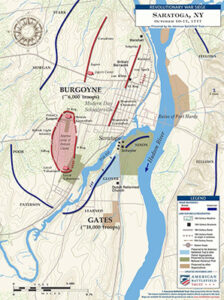A BGES Revolutionary War Field University Program
With Scott Patchan
May 7-10, 2025; from Lake George, NY
 In October 1777, events in North America took a decisive turn with the defeat and surrender of British forces under Gen. Johnny Burgoyne at Saratoga. This pivotal event, marked by the capitulation of a major British army, emboldened King Louis XVI of France to expand his war with Britain to the North American continent for the first time since the ill-fated French and Indian War. The French alliance, forged by King Louis XVI, provided land, naval, and economic resources essential to the colonial war effort. This investment paid huge dividends four years later when a second major British army, led by Gen. Earl Cornwallis, surrendered to the combined American and French forces under Gen. George Washington at Yorktown.
In October 1777, events in North America took a decisive turn with the defeat and surrender of British forces under Gen. Johnny Burgoyne at Saratoga. This pivotal event, marked by the capitulation of a major British army, emboldened King Louis XVI of France to expand his war with Britain to the North American continent for the first time since the ill-fated French and Indian War. The French alliance, forged by King Louis XVI, provided land, naval, and economic resources essential to the colonial war effort. This investment paid huge dividends four years later when a second major British army, led by Gen. Earl Cornwallis, surrendered to the combined American and French forces under Gen. George Washington at Yorktown.
We know the outcome—but how did the miracle at Saratoga unfold? Join us and find out.
The tour will focus on Burgoyne’s strategy and decisions as the initially successful campaign begins with British victory at Fort Ticonderoga and Hubbardton. The eventual American triumph at Saratoga was a collective effort, with commanders from a wide background contributing to the British Army’s delay and ultimate defeat. Rugged men such as Ebenezer Francis, Seth Warner, and John Stark engaged in critical battles at places such as Hubbardton and Bennington, slowly wearing down the British forces even amid initial setbacks.
Meanwhile, Horatio Gates was assembling an army at Saratoga, bolstered by figures like Benedict Arnold and Daniel Morgan with his sharpshooting riflemen from the Shenandoah Valley. Amid controversies and internal conflicts, this disparate yet determined force achieved one of the most crucial victories of the war.
Itinerary
Wednesday, May 7, 2025
Meet at 8 p.m. in the lobby of the Holiday Inn Resort in Lake George, New York, for an orientation and to pick up your nametag and maps.
You and your cohort will enjoy Scott’s introductory discussion of the factors leading to Burgoyne’ Campaign and Lord Howe’s response. You will get profiles of the key personalities and the critical questions that would bring the contending armies to this Hudson River showdown.
Eat dinner beforehand. Dinner and the hotel are on your own.
Thursday, May 8, 2025
After arriving in Canada, Burgoyne moved with alacrity, much to the distress of the commanding Gen. Sir Guy Carlton. Departing the hotel at 8 a.m., this morning’s travel takes us to Crown Point a few miles above Fort Ticonderoga. Burgoyne’s arrival here announced that this theater would be contended. Although today it is a ruin, Crown Point was a magnificent fortress of Empire built to house the British Army during the French and Indian War. Perhaps Burgoyne thought the site would provide protection as he plotted his operations more than 20 years later.
Crown Point provides a grand location to talk about the preliminaries and how Lake Champlain had played in military operations to date. After the discussion we will move, like Burgoyne did, against Fort Ticonderoga, which at this point was commanded by Gen. Arthur St. Clair. Of the many fortifications in the Western Hemisphere, none is more impressive than Fort Ti. Here, during the French and Indian War, French forces stunned the British, inflicting a bloody defeat.
Fort Ticonderoga had a key vulnerability: its surrounding elevated terrain. As impressive as the fort was, Mounts Defiance and Independence controlled the fort, and it could not be held without also controlling these heights. You will see both. This will wrap our day.
Lunch is included, but dinner and the hotel are on your own.
Friday, May 9, 2025
Burgoyne’s early successes drove the Americans from Ticonderoga in two wings south. A naval flotilla headed south down Lake Champlain to East Bay, and a column marched toward Vermont (known then as the New Hampshire Grants). The rebels were under the command of Col. Ebenezer Francis, and they were pursued by British forces under the very capable Gen. Simon Fraser.
Leaving the hotel at 8 a.m., we will pick up that pursuit to Hubbardton, a lovely and unlikely field of conflict marked by pristine viewsheds that make it easier to see the fighting in your mind’s eye. Hubbardton was a tactical defeat for the Americans, but it did buy time for other forces to assemble, which would bloody the British.
From Hubbardton, we will skedaddle to Skenesborough Harbor at White Hall, where a ramshackle American fleet was defeated. The harbor worked well for Burgoyne, and he would occupy the site as a supply depot. Burgoyne made an important mistake here in that the occupation duties slowed his pursuit, allowing the Americans time to catch their breaths and plan for the next phase of operations.
As Burgoyne pushed south, we will talk about a brief action at Fort Anne and then continue onward to Fort Edward. Here we will visit the grave and discuss the tragic story of Jane McCrea. Her murder at the hands of the British and their Native American allies angered and inspired the colonists to renew their resistance throughout the North American continent. We will finish the day at Fort George.
Lunch is included, but dinner and hotel are on your own.
Saturday, May 10, 2025
Our last day will bring us to the same culmination that the British experienced at Saratoga. Revolutionary War battles are not of the same scale as many later wars, but a more significant field cannot be found anywhere in America. Departing the hotel at 8 a.m., our first stop is at Bennington, where we will have followed the route of German mercenaries under the command of Col. Frederich von Baum. While looking for food, they ran into Americans under the command of Gen. John Stark and were routed—a great success for the Americans, who were showing a stiffening spine.
Finally, we will reach Saratoga, where we will spend the remainder of our day. Here, two independent but mutually supportive operations took place: the battle of Freeman’s Farm on September 19 and the battle of Bemis Heights on October 7. In the former fight, General Gates fended off a British effort to encircle Bemis Heights, and in the later, perhaps the most tragic figure of the American Revolution, Benedict Arnold, in combination with Gen. Daniel Morgan, delivered a decisive assault that breeched the British lines and resulted in a decisive American victory that compelled Burgoyne’s surrender.
After visiting the surrender site, we will return to our hotel—our mission completed. This is perhaps the most important study of the Revolutionary War period.
Lunch is included, but if you stay the night, dinner and the hotel are on your own.
About the Faculty
 A lifelong student of military history, Scott C. Patchan’s interest began as a child during summer visits to his grandparents’ home in Uniontown, Pennsylvania, which often included a sojourn to nearby Fort Necessity National Battlefield. Walking those historic grounds and learning from the interpretive staff created the foundation for his interest in the study and preservation of America’s historic sites. He grew up in Cleveland, Ohio, and graduated from James Madison University in the Shenandoah Valley of Virginia.
A lifelong student of military history, Scott C. Patchan’s interest began as a child during summer visits to his grandparents’ home in Uniontown, Pennsylvania, which often included a sojourn to nearby Fort Necessity National Battlefield. Walking those historic grounds and learning from the interpretive staff created the foundation for his interest in the study and preservation of America’s historic sites. He grew up in Cleveland, Ohio, and graduated from James Madison University in the Shenandoah Valley of Virginia.
He has published seven books with a heavy focus on the 1864 Shenandoah Valley Campaign of the Civil War. His most recent works include George Washington in the French and Indian War; Worthy of a Higher Rank: The Shenandoah Valley Campaign Journal of Col Joseph Thoburn; The Last Battle of Winchester; Shenandoah Summer; Second Manassas: Longstreet’s Attack and the Struggle for Chinn Ridge; and The Forgotten Fury: The Battle of Piedmont, Virginia. Over the years, he has also written six feature length essays for Blue and Gray Magazine and dozens of articles and essays for various other publications. He is currently completing books on the Battle of Jonesboro in the Atlanta Campaign and the Battles of Fisher’s Hill through Cedar Creek. Each year, he conducts numerous historical tours and seminars on the colonial era, the Revolutionary War and the Civil War throughout the eastern United States. He currently resides in the Wilderness area of Spotsylvania County, Virginia, and is active in preservation and interpretive efforts with the Shenandoah Valley Battlefield Foundation and Kernstown Battlefield Association.
Hotel Information
The headquarters hotel is the Holiday Inn Resort, 2223 State Route 9, Lake George, New York, 12845; 518-668-5781. Ask for the Blue and Gray Education block. The rate is $149 plus tax. Cutoff date for the block is April 4, 2025.
Transportation
The servicing airport is Albany, New York. It is approximately 53 miles north to Lake George, which is easily accessed by I-87.
Recommended Reading
You will be provided with maps upon arrival. The following books are suggested to enhance your readiness for the program. These books are available online.
- Douglas R. Cubbison: Burgoyne and the Saratoga Campaign: His Papers
- Robert Dunkerly: An Explorer’s Guide America’s Revolutionary War
- Michael P. Gabriel: The Battle of Bennington: Soldiers and Civilians
- Richard Ketchum: Saratoga: Turning Point of America’s Revolutionary War
- Eric Schnitzer and Don Troiani: Don Trolani’s Campaign to Saratoga–1777: The Turning Point of the Revolutionary War in Paintings, Artifacts, and Historical Narrative
- Bruce M. Venter: The Battle of Hubbardton: The Rear Guard Action that Saved America
- Kevin Weddle: The Compleat Victory: Saratoga and the American Revolution
Registration
To register by mail or fax, download this printable registration form: Saratoga: America’s Decisive Victory.
Questions? Need more information? Please contact us.
